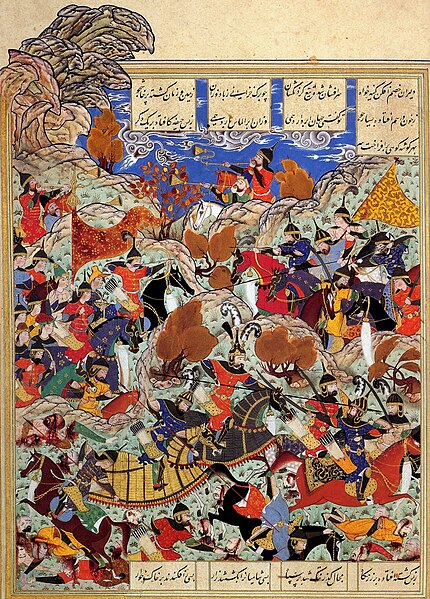Kamāl ud-Dīn Behzād, also known as Kamal al-din Bihzad or Kamaleddin Behzād, was a Persian painter and head of the royal ateliers in Herat and Tabriz during the late Timurid and early Safavid Periods. He is regarded as marking the highpoint of the great tradition of Islamic miniature painting. He was well known for his very prominent role as kitābdār in the Herat Academy as well as his position in the Royal Library in the city of Herat. His art is unique in that it includes the common geometric attributes of Persian painting, while also inserting his own style, such as vast empty spaces to which the subject of the painting dances around. His art includes masterful use of value and individuality of character, with one of his most famous pieces being "The Seduction of Yusuf" from Sa'di's Bustan of 1488. Behzād's fame and renown in his lifetime inspired many during, and after, his life to copy his style and works due to the wide praise they received. Due to the great number of copies and difficulty with tracing origin of works, there is a large amount of contemporary work into proper attribution.

Kamāl ud-Dīn Behzād
Depiction of Behzad, from Shah Tahmasp's album
Battleground of Timur and the Mamluk Sultan of Egypt.
The construction of Khawarnaq castle (Arabic الخورنق) in al-Hira, c. 1494-1495 C.E.
A Persian miniature is a small Persian painting on paper, whether a book illustration or a separate work of art intended to be kept in an album of such works called a muraqqa. The techniques are broadly comparable to the Western Medieval and Byzantine traditions of miniatures in illuminated manuscripts. Although there is an equally well-established Persian tradition of wall-painting, the survival rate and state of preservation of miniatures is better, and miniatures are much the best-known form of Persian painting in the West, and many of the most important examples are in Western, or Turkish, museums. Miniature painting became a significant genre in Persian art in the 13th century, receiving Chinese influence after the Mongol conquests, and the highest point in the tradition was reached in the 15th and 16th centuries. The tradition continued, under some Western influence, after this, and has many modern exponents. The Persian miniature was the dominant influence on other Islamic miniature traditions, principally the Ottoman miniature in Turkey, and the Mughal miniature in the Indian sub-continent.

Yusuf and Zulaikha (Joseph chased by Potiphar's wife), by Behzād, 1488
Camp scene from late in the classic period, with no frame (c. 1556-1565), Freer Gallery of Art, Washington, D.C.; Majnun (at top wearing orange) spies on his beloved Layla (standing in tent doorway).
Saki, album miniature by Reza Abbasi, 1609
Complex palace scene, 1539–1543, Mir Sayyid Ali








